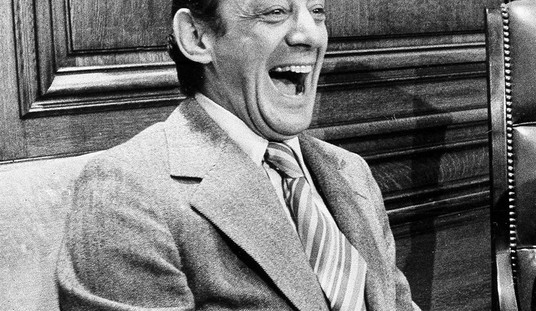Why is the photograph of the flag being raised atop Mount Suribachi so iconic and meaningful? Many of us can’t look at the photo without getting a lump in our throats. There is just something so determined, so resolute, so brave about the Marines and that flag and what it cost them to put it up.
Seventy years ago today, AP’s Joe Rosenthal snapped a picture that, once published at home, became the most reprinted photo of World War II. The Marines who helped raise the flag — those left alive after the battle — were brought home to help sell war bonds. A statue was sculpted of that moment to grace the Marine Corps War Memorial at the entrance to Arlington National Cemetery — so lifelike you expect the flag to continue going up and the Marines to kick back and have a smoke after a job well done.
The memorial is dedicated to all Marines who have died since 1775.
The backstory about that photograph is fascinating, as CNN’s Thom Patterson writes:
On February 23, 1945, Rosenthal, an AP photographer covering the battle for Iwo Jima, had heard Marines were headed up the mountain. He decided to make the climb and see what was going on.
But Sgt. Louis Lowery, a Marine photographer for Leatherneck magazine, had beat him to it. Lowery was already on the summit snapping photos of Marines proudly raising the American flag.
For miles around, the sight of Old Glory atop the mountain set off whistles, gunfire and celebrations. The noise stirred up a firefight with Japanese soldiers near the summit. Lowery dove for cover and fell 50 feet, smashing his camera.
Lowery decided to descend the mountain to get new equipment. On the way, he ran into Rosenthal coming up with two Marines: Pfc. Bob Campbell, who was also a photographer, and Sgt. William Genaust, who was a motion picture photographer.
According to Buell, Lowery said, “Hey, you’re late fellas, there’s already a flag up there.” Lowery told Rosenthal that he should keep going to experience the breathtaking view.
As Rosenthal got closer to the summit, the flag began to come into view.
“He stopped and was struck by a wave of emotion about what it cost to put that flag up there,” Buell said. Rosenthal thought about all the bloody fighting and the Marines who sacrificed their lives to capture the mountain.
Reaching the top, Rosenthal, Campbell and Genaust spotted a group of Marines holding a second flag. The Marines said they’d been ordered to replace the first flag with a bigger one so more people could see it below.
Suddenly Rosenthal knew he had a second chance to photograph an important moment on the summit.
Let’s stop a minute and remember that this was long before today’s sophisticated cameras and digital technology. Photographers took one picture at a time, often with only one opportunity to get the perfect shot.
Rosenthal had to quickly decide whether to shoot both flags simultaneously — one rising while the other lowered — or to photograph the second flag as it was being raised.
He chose to focus on the second flag.
Hal Buell, a former AP photo editor, explains why capturing the picture was a serendipitous moment:
“It’s exquisite,” Buell said. “You have this strong, diagonal line made by the flag staff. You have the flag snapping in the breeze. You have the pyramid-like shape of the Marines pushing the flag up. The men obviously are separate, but they appear as one. The blank background enhances the action by providing no distractions. Also, the photo is gifted with a softly filtered light. A very thin haze of clouds filters the light so that the shadows aren’t harsh, but there is detail in all the shadows on the uniforms and the flag.”
Think about it: At the exact moment that Genaust cued Rosenthal, sunlight, shadows, wind and the Marines all converged perfectly.
What were the chances?
“I hate to use the word accident,” Buell joked. “Let’s call it serendipity.”
Perhaps the dramatic nature of the battle contributed to the iconography of the picture. An island two miles long and four miles wide contained more than 50,000 fighting men. The 22,000 Japanese were incredibly well dug in, literally burrowing into the ground with 11 miles of tunnels as well as numerous caves. The volcanic ground was a nightmare to traverse.
The flag raising occurred on the 5th day of the battle, and far from signaling the island was in American hands, the flag raising was only a brief respite from combat that would last several more weeks. Only 216 of the 22,000 Japanese defenders surrendered. The Americans lost 6821 killed and more than 19,200 wounded.
After the picture went viral, FDR brought the flag raisers home for the 7th Bond Drive. It was a spectacular success, raising more than $26 billion — twice what was expected.
Clint Eastwood brought the story to the screen with his Flags of our Fathers (Iwo Jima told from the American perspective) and Letters from Iwo Jima (told from the Japanese point of view).
But most of us remember watching the John Wayne classic when we were kids, Sands of Iwo Jima and the moment of the flag raising in the film which conveyed both the triumph and tragedy of the battle:
The picture was published at a time when war weariness was seeping into the civilian population. Germany had just been beaten back after the Battle of the Bulge and the casualty lists from the Pacific theater were horrendous. The photo lifted the spirits of the people in a way that victory on the battlefield perhaps could not. In no small way, the photograph contributed to the final victory.












Join the conversation as a VIP Member